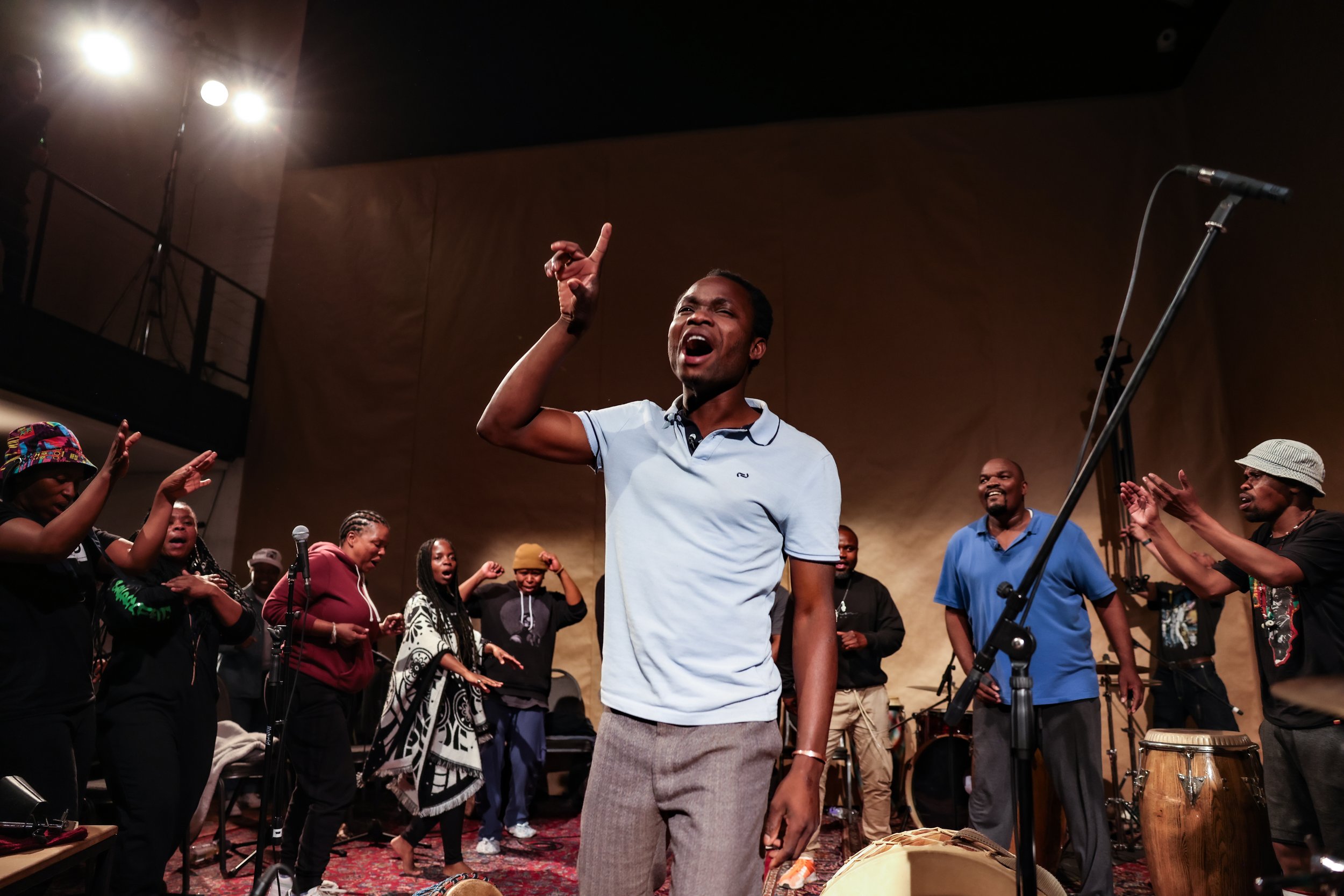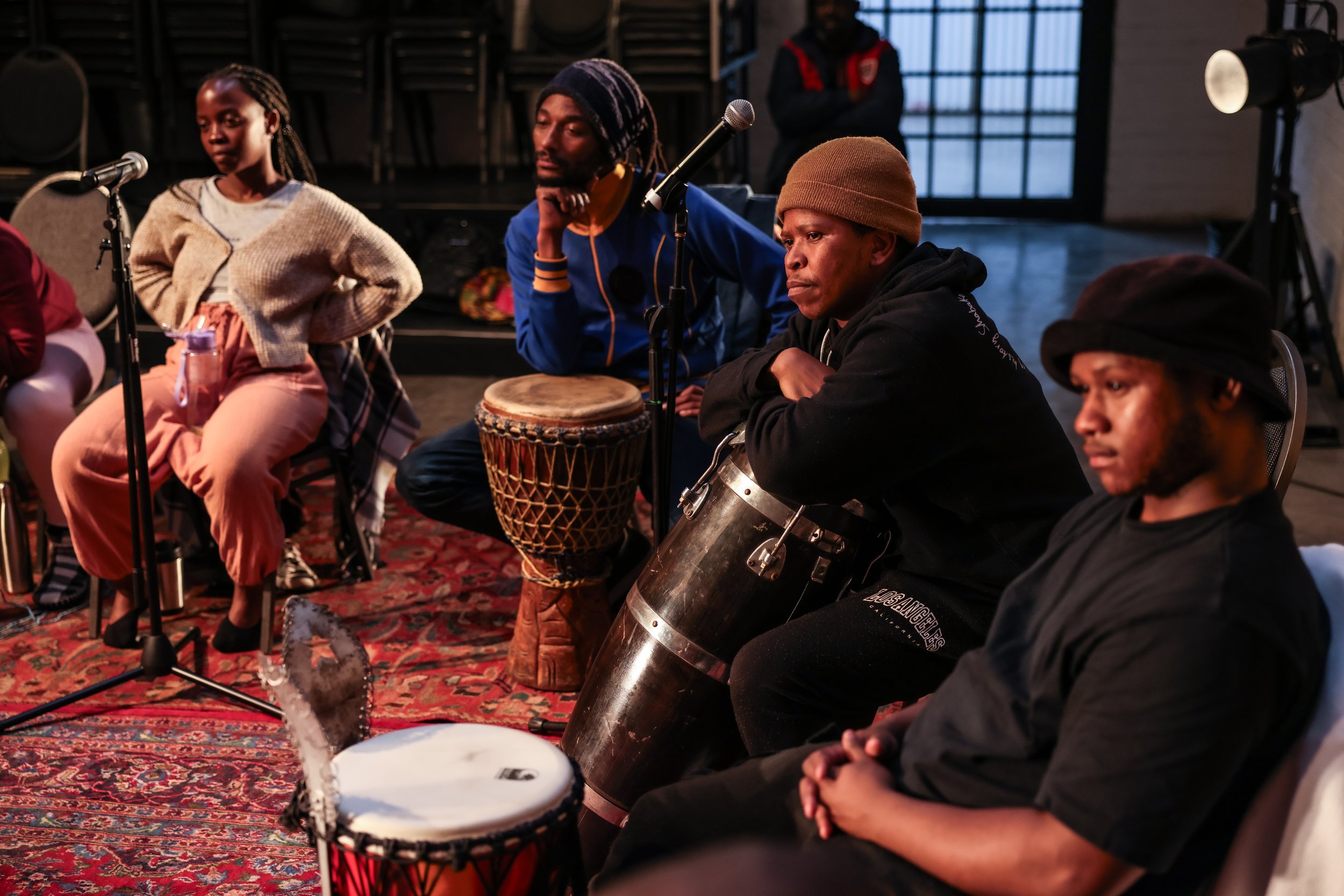THINKING IN PERCUSSION | A MENTORSHIP BY ANGELO MOUSTAPHA & TLALE MAKHENE
What does it mean to use the body as a percussive instrument? How can the inherent rhythms of the body be surfaced and translated into live movement and sound?
From 17 to 18 August, SO | The Academy for the Less Good Idea, hosted the Thinking In Percussion mentorship. Led by percussionists Angelo Moustapha and Tlale Makhene, the mentorship saw 10 musicians growing their knowledge of rhythm and exploring the transposition of this knowledge onto their own instruments.
A dialogue between musical traditions
For Moustapha and Makhene, the dialogue between the two musical traditions informing their respective practices – West African music and Siswati music – and how each of them is not only inspired by these traditions, but how they resist and reinvent them, is central to their engagement with percussion.
For Makhene, childhood games and songs from significant cultural events such as weddings and birthdays inform a great deal of his practice. In these songs and games, he explains, one learns to draw on the inherent rhythms of the body, and to create music using only the body and the voice.
The difference between Western and African musical notation is what shapes Moustapha’s approach to music. Growing up, he explains, it was the songs he listened to and performed in church that afforded him a very particular relationship with instrumentation and improvisation.
For both, these points of entry into percussion involved embracing collaboration and locating rhythm in the body.
Embodied rhythm and memory
“Before we pick up any instruments, we will begin with the body. The primary instrument is the body.” – Tlale Makhene
While the two-day mentorship is hugely generative, Makhene and Moustapha do not come in with any prescribed ways of working, neither do they work towards any certain ends. Rather, the learning is in the doing, and the aim is to develop a collective melody, held in the memory of the body. “Learn the melody and the body will take it in,” says Makhene.
Moustapha brings his own composition to the participants, but asks for it to be co-authored, and co-composed by the group. In this way, it becomes a burgeoning composition, a process of laying down a certain pattern or rhythm, repeating it, embodying it, and moving on to the next one.
Similarly, rhythm and percussion are not limited to conventional percussive instruments. Among the variety of drums present in the room are pan drums, electronic synthesisers, vocalists and gum boots. Over the course of the mentorship, all of them are activated and folded into a collective composition.
Collaborative composition
Collective thinking is central to the Thinking In Percussion mentorship. Day one of the mentorship begins with an exercise in familiarisation. In The Centre space, filled with carpets, and with brown paper lining the walls, the participants are seated in a circle with their instruments.
The introductions take the form of individual demonstrations towards collaborative ends. Led by Tlale, it is an exercise in introducing each other's skills, but also interests. There is a short demonstration of each person’s musical, rhythmic, and percussive ability and it is here where the initial sparks emerge, and where early connections and potential collaborations are established.
“In these spaces, we hold each other in ways that are unique to collectives,” explains Makhene. “Every member in this group is bringing their own happiness, sadness, history, and energy. They are bringing who they are, they are bringing their names. You carry these things home with you – these names and these sounds.”
This collective way of working is carried through the mentorship. It is an active and engaged form of listening and communicating.
Considering Moustapha’s primary language is French, much of his communication with the room becomes musical and non-verbal. Rather than hindering the process, it becomes an opportunity to embrace the activity of the room through embodied and engaged listening.
“Listen to the room,” says Moustapha “Rhythm is interesting in that people respond to it in different ways even though they’re hearing the same thing.” Working collectively, then, requires an active and engaged listening to one's fellow musicians. In both the workshops and The Open Moment, musicians communicate primarily through sound and through non-verbal gestures, giving way to myriad moments of connection within the greater ensemble.
The Open Moment
The Thinking In Percussion mentorship culminated in The Open Moment, a public showing and an opportunity for the audience to witness and participate in the material and improvisations explored throughout the two-day mentorship.
Opening with a body percussion exercise led by mentorship participant Micca Manganye, audience members are invited into the space as participants. Makhene and Moustapha involve the audience in similar ways, extending their collaborative compositional strategies to the room.
Altogether, The Open Moment is a demonstration of the artistic processes and strategies employed by Makhene and Moustapha when composing and improvising in a collaborative manner.
– David Mann
PHOTOGRAPHER | Zivanai Matangi
CREDITS
THINKING IN PERCUSSION MENTORSHIP
MENTORS | Tlale Makhene & Angelo Moustapha
PARTICIPANTS | Decius Pitjadi, Gareth Steele, Gontse Makhene, Nonhlanhla Ndhlovu, Pertunia Msani, Sifiso Bogale, Siyabonga Mthembu, Tamara Ringas, Tshegofatso Khunwane, Zandile Hlatshwayo, Vusi Mdoyi, Teresa Phuti Mojela & Micca Manganye
MOMENTEUR FOR THE SO ACADEMY | Athena Mazarakis
THE OPEN MOMENT
MENTORS | Tlale Makhene, Angelo Moustapha & Micca Manganye
PARTICIPANTS | Decius Pitjadi, Gareth Steele, Gontse Makhene, Nonhlanhla Ndhlovu, Pertunia Msani, Sifiso Bogale, Siyabonga Mthembu, Tamara Ringas, Tshegofatso Khunwane, Zandile Hlatshwayo, Vusi Mdoyi, Teresa Phuti Mojela & Micca Manganye
MOMENTEUR FOR THE SO ACADEMY | Athena Mazarakis



